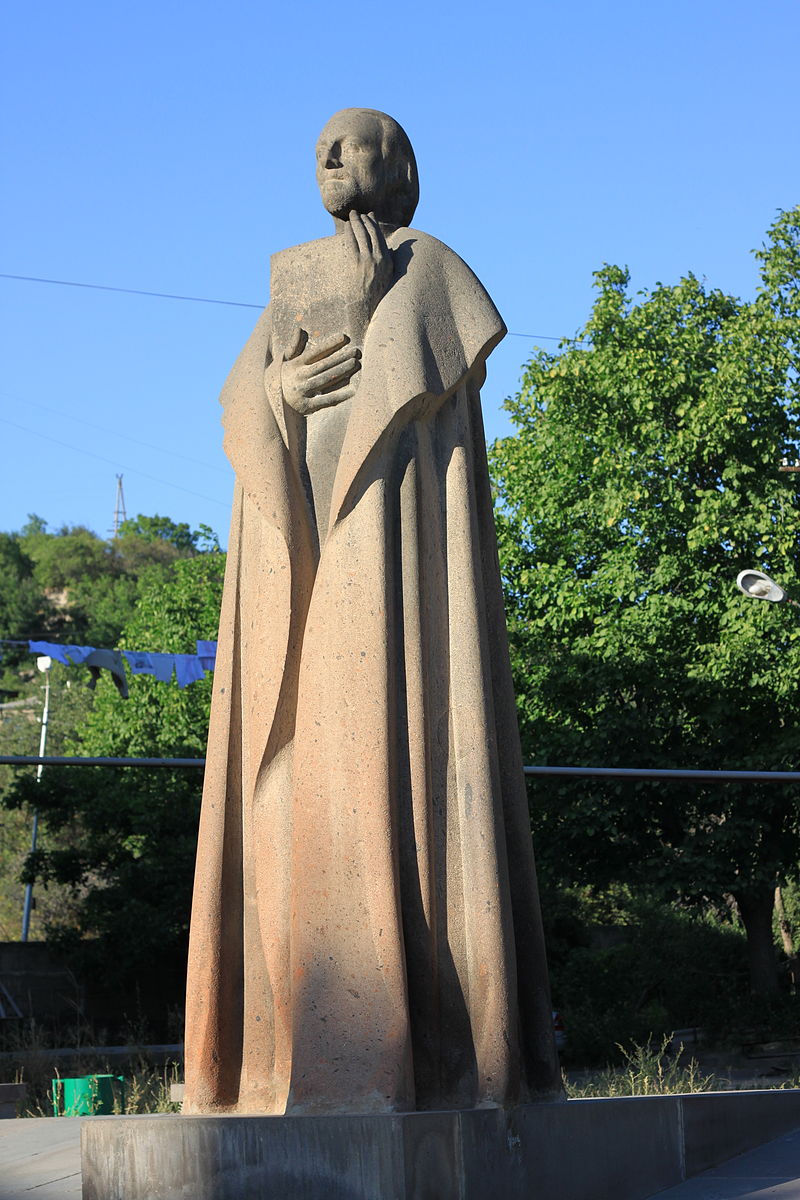
A statue of Nicholas Adontz near the
museum of history of Sisian, named after him.
He was born Nikoghayos Ter-Avetikian in the village of Brnakot (Sisian, region of Siunik/Zangezur) on January 10, 1871. He traced his roots to Ter Avetik, a priest who was a close ally to David Bek, the hero of the Armenian rebellion of Siunik from 1722-1728. He studied for a very short period at the monastic school of Tatev and then at the Gevorgian Seminary of Holy Echmiadzin (1882-1891). He interrupted his studies and moved to Tiflis, where he studied Russian for a year and then entered the second year of the Russian gymnasium (1892-1894). He adopted the last name Adontz, derived from an ancestor of their family, to avoid being called “Ter-Avetikov.”
Adontz’s dreams to pursue higher education were fulfilled thanks to the sponsorship of benefactor Alexander Mantashov (Mantashiants). He first studied at the School of History and Philology of the University of St. Petersburg (1894-1899), where he had among his teachers the famous Orientalist Nikolai Marr. After graduating from the university, Mantashov sponsored his three-year sojourn in Europe, where Adontz studied and researched in Munich, Paris, Oxford, and Venice. In 1902, once the agreement was finished, he returned to St. Petersburg, where he passed his examinations for a master’s degree. Then he went to the Caucasus, where he studied the manuscripts of Echmiadzin and Tiflis. He also published a journal of Armenian literature, Banber grakanutian yev arvesti (1903-1904).
In 1908 Adontz published Armenia in the Period of Justinian in Russian, a remarkable study on the social and political structures of early medieval Armenia. He defended it as his master’s thesis in April 1909 and was appointed assistant professor at the University of St. Petersburg. His second monograph in Russian, Dionysus of Thrace and the Armenian Commentators, published in 1915, was an edition, along with the Greek original, of the early medieval Armenian translation of the grammar of Dionysus Thrax (a Greek grammarian of the second century B.C.), based on 30 manuscripts. He defended it as his Ph.D. dissertation and was appointed professor of the chair of Armenian and Georgian philology in 1916.
Also in 1916, Adontz first participated in the works of an archaeological expedition to Mush and Erzerum, and later headed an expedition to Van, at a time when Western Armenia was mostly occupied by Russia. In 1917-1918 he became honorary trustee of the Lazarian College of Moscow. After the October Revolution, he successfully fought to avoid that the Armenian manuscripts from Echmiadzin, and the Armenian libraries of the Lazarian College and the Moscow churches were incorporated into the “Alexander III” library of Moscow. In the spring of 1920 the Russian Academy of Sciences decided to send him abroad in a six-month study trip. The Armenian scholar did not wait for the documentation to be completed and left Russia on his own.
Adontz, who had actively participated in political activities about the Armenian Question in the 1910s, first settled in London and published the book Towards the Solution to the Armenian Question (in English, 1920). The next year he moved to Paris, where he had been named consultant for the Armenian National Delegation. He married singer Olga Hovnatanian and lived in the French capital for the next ten years. He continued publishing and lecturing, supported by benefactor Abraham Ghoukassiantz.
In 1931 an Armenian Studies chair, funded by millionaire Robert Werner; Eva-Zarouhi Nubar, Countess d’Arschot Schoonhoven (daughter of Boghos Nubar Pasha, founding president of the Armenian General Benevolent Union), and the Armenian community of Brussels, was founded within the Center of Oriental Studies at the Free University of Brussels (Belgium). Adontz was appointed to the position. He would teach an array of courses on Classical and Modern Armenian, as well as subjects of Armenian and Byzantine Studies, while continuing his publications and lectures.
However, Brussels did not offer him peace of mind. After a long illness, his wife passed away in 1935. He was deeply affected by this loss, and its impact took a strong toll from his body. In May 1940 Belgium was occupied by Nazi Germany. Adontz’s health problems became worse and he was diagnosed with pulmonary tuberculosis. He was admitted to a hospital in October 1941 and passed away on January 27, 1942. He was buried in the cemetery of Brussels. Adontz left more than 120 scholarly articles and monographs on the history and literature of Medieval Armenia, Armenian-Byzantine relations, Armenian-Greek philology, mythology, religion, and linguistics, in Armenian, Russian and French. In the last years of his life, he worked on a history of Armenia from the beginnings to the twentieth century, but he only completed the first volume (Paris 1946; Armenian translation, 1972). A collection of his most important Armenian-Byzantine studies was published in French (1965). The importance of his works for scholarship is evidenced by the fact that Armenia in the Period of Justinian was translated into English and published by historian Nina Garsoian in 1970 with revisions, a bibliographical note, and appendices (an Armenian translation appeared in 1987), while Dionysus of Thrace and the Armenian Commentators was published in French in 1971. Many of his works have appeared in Armenian since 1989, including a six-volume collection published in Yerevan from 2006-2011.